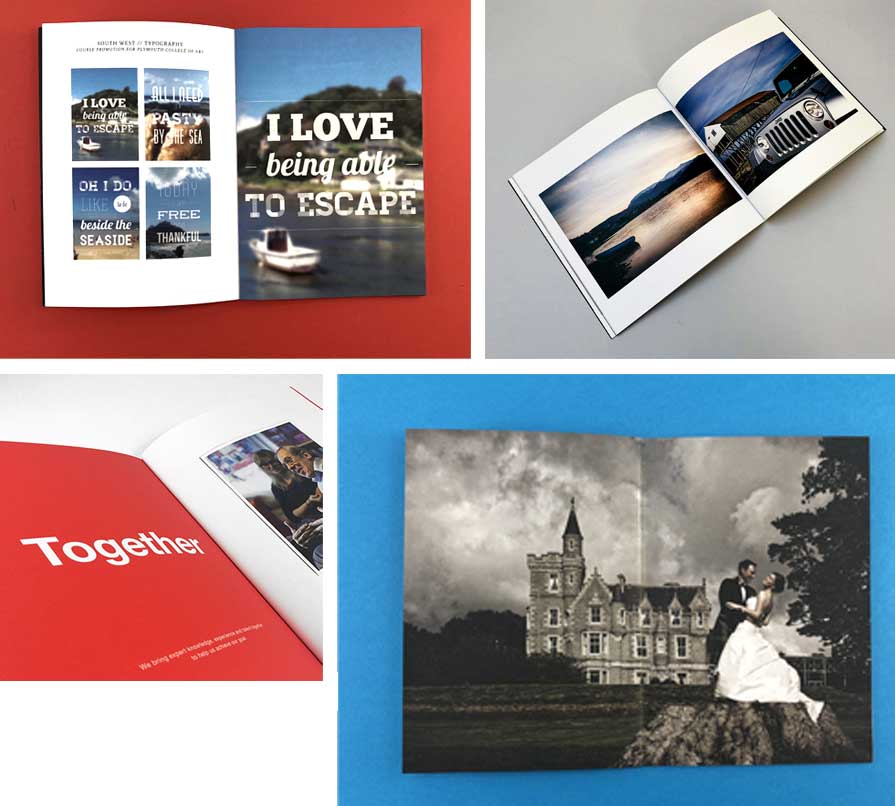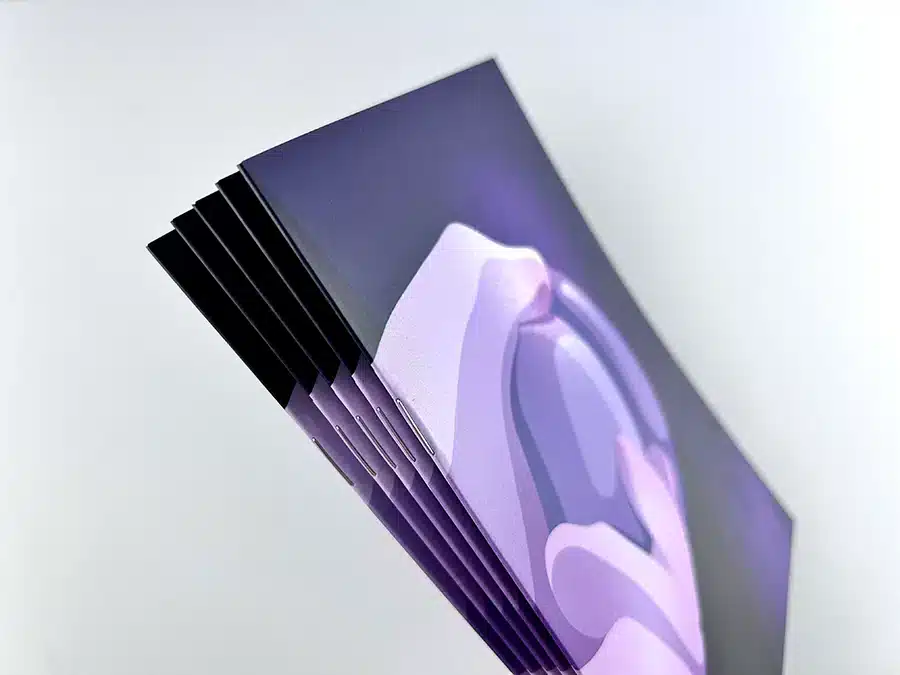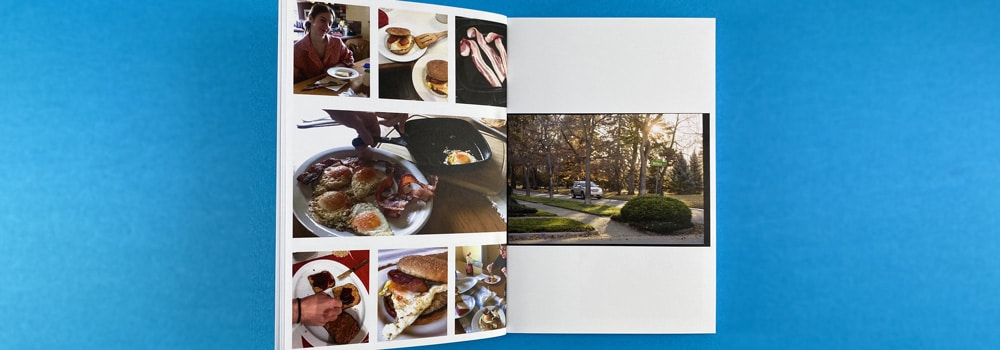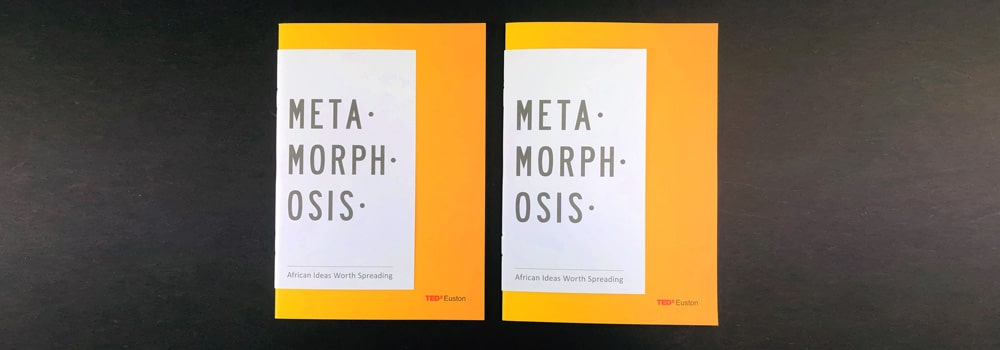
Ever tried folding a piece of paper just right, only to look like a crumpled mess? Now imagine that with an entire booklet, and you'll understand why many people break a sweat when it comes to printing. Whether you're crafting a sleek marketing brochure, a personal portfolio, or a small magazine, getting the page arrangement right is essential for best results.
But don't worry—it's not as complicated as it seems. You can quickly and confidently design and arrange your booklet pages with the right approach. Think of this blog as your blueprint to booklet success. We break down the process step by step, ensuring your final product looks professional, polished, and purposeful. So let's begin!
We will just need a high res PDF file to go ahead. SO do use the program you are most comfortable with laying out the artwork in. Ensure that you are happy with how everything looks on the page, then Export or Save As PDF. Easy!
We'll give the files a thorough check and preflight when they arrive and at that stage we will flag up anything that doesn't look right so you can change it before printing.
Ready to place an order? Click Here and Let’s Go!
You need to understand some fundamentals to anchor your journey in booklet printing. For instance, the order of the blank pages and the booklet page is vital to ensure an easy and logical flow for readers. Additionally, you must learn about the various printing settings and how they affect the outcome. This includes understanding the importance of page order and differentiating between reader spreads and printer spreads.
When designing a booklet, getting the page order right is key to creating a smooth, enjoyable reader experience. Think of it like telling a story: each page should naturally lead to the next, guiding the reader effortlessly through the content. A misstep in page order can be jarring, causing confusion and frustrating your audience—not something you want in a polished, professional piece.
Not only does a proper page order make your booklet more engaging, but it also prevents costly production issues. Incorrectly arranged pages can lead to delays and wasted resources, especially if you must reprint the entire booklet. By ensuring your pages are in the correct order from the start, you avoid these headaches and create a booklet that's easy to read, flows well, and looks great.
Next, understanding the difference between Reader Spreads and Printer Spreads can significantly impact your booklet printing process. Here is a simple explanation:
Printer Spreads: These display booklet pages as they appear when printed side-by-side on a sheet. They reflect a sequential arrangement when folded and bound into a booklet. However, if the book printing layout is only set to printer spreads, and you decide to print in a different layout later on, you might face difficulties and increased costs.
Reader Spreads: This denotes a pair of pages that face each other in a booklet. The page order is based on their numbers. Reader Spreads offer a preview of how your booklet will look once bound, but sending them to the printer directly might lead to problems as the saddle-stitched order does not work this way.
When preparing your book layout for printing, it's crucial to consider how the page count and binding method will influence its overall appearance and usability. Your booklet's page count must align with the binding technique chosen, considering each binding method's minimum and maximum page limits. Let's learn about these elements below.
The number of pages your booklet contains is determined by its content and binding method.
Here is a general guideline:
Binding Method | Minimum Pages | Maximum Pages |
|---|---|---|
Stapled | 8 | 72 |
Perfect Bound | 32 | 400 |
Hardback | 32 | 400 |
Remember, too few pages might render your booklet too thin, and too many pages can make it bulky and expensive to print. Therefore, striking the right balance for an optimum reader's experience is essential.
Your binding method affects not only the aesthetic appeal of your booklet but also its durability and ease of use. Here are different binding methods you might consider:
Stapled: This method works great for documents with fewer pages. It's cost-effective and gives a neat finish.
Ideally Bound: This method is perfect for booklets with many pages. It gives a professional and elegant look.
Wire-o: Offers a contemporary finish and allows the booklet to lie flat when open, providing ease of scrolling through pages.
Remember, the choice of binding impacts the maximum limit of pages that can be included in your booklet.
Meanwhile, do you want to simplify the process when choosing printing methods? ExWhyZed offers a range of professional printing methods to suit different booklet needs, including staple-bound (saddle-stitched) and perfect-bound (PUR-bound) options.
Whether you need a sleek, stapled booklet for up to 48 pages or a durable, glued spine for thicker publications, Exhyzed ensures high-quality finishing for every project. Their advanced printing techniques guarantee crisp visuals, sharp text, and a polished appearance.
To explore our full range of printing solutions and find the best fit for your booklet, check out our Booklet Printing in 2025 guide.

Are you still trying to figure out, "how to layout a book for printing"? Once you've determined your booklet's page count and binding method, you can begin designing and formatting. Below, we'll discuss these aspects.
When designing your booklet, the right margins and font can significantly affect how easily your audience reads your content. Margins, typically around 13mm to 18mm, give your booklet room to breathe, ensuring it doesn't feel cramped. It's like giving your words some space to stand out.
And the font? It's all about readability. Fonts like Garamond or Georgia work well because they're easy on the eyes, but you should always choose a font that fits the vibe of your booklet.
Remember, you don't want your reader squinting or straining to read your text—a font that's too small or fancy can make your message hard to absorb.
Style consistency is key to making your booklet feel cohesive and professional. Keep your font, color, and alignment consistent across pages unless you're breaking it up intentionally for emphasis (like with headings or special sections).
The goal is to make your booklet easy to follow without sudden design jolts. And let's talk page numbers — they're more than just a small detail. Proper page numbering helps your readers stay on track, guiding them through your content without confusion.
To maintain a clean, streamlined look, keep them at the bottom, centered, and in a smaller font.
In our digital age, various software applications aid in booklet preparation. Let's quickly have a look at some of the best software available in the market:
Adobe Acrobat or Adobe Reader: Has a 'booklet printing' feature that arranges two pages per sheet to ensure a seamless reading order after binding and folding, making the most of both sides of the paper.
Microsoft Word: Provides pre-defined templates for booklets. However, learning to use its advanced features might require a learning curve.
Lulu's Book Template: This offers easy-to-use templates for different booklet sizes, genres, and designs.
InDesign: A premium tool with robust features for booklet design and arrangement.
Knowing when to send the cover as a separate file depends on several factors, like the thickness of the cover and the binding method you choose. For example, suppose you're working with a saddle-stitched booklet. In that case, the cover is usually thicker than the inside pages, so sending it as a separate file helps the printer give it extra sturdiness. This is especially important if you want a high-quality, professional finish.
However, sending the cover in the same file as the inside pages works fine if you're not focused on thickness and want a more straightforward approach. It's faster and easier, but you may lose some control over the final finish.
Do you want to print your new booklet but are confused on how to make it look worthy and moreover professional? Do you need expert help for the same? At ExWhyZed, we don't just help you arrange pages for booklet printing — we guide you through the entire process from start to finish. Whether you're unsure about the right binding method, need expert design advice, or need assistance with software tools, our team ensures every detail is meticulously handled. From page order to final print-ready files, we ensure your booklet aligns perfectly with your vision and is ready to impress.
Ready to bring your booklet project to life? Contact us today and let ExWhyZed take the stress out of printing. We'll handle everything so you can focus on what matters most — sharing your content with the world.
To wrap things up, getting your booklet pages in order might feel like a challenge, but with the right steps and tools, you'll be able to tackle it like a pro. By focusing on key elements like page order, binding, font choice, and consistency, you're setting yourself up to create and enhance the reader’s experience by creating a product that reflects your vision.
As technology evolves, printing has never been easier or more efficient. So, take what you've learned, fine-tune your design, and get ready to impress your audience with a booklet that looks polished, professional, and well-crafted — a true reflection of your hard work and creativity.
If you're up for your printed journey and need a helping hand, quickly get a quote by ExWhyZed now!
To set a booklet layout for printing with a PDF printer, you must first design single pages in consecutive order. Use appropriate software to choose the 'Booklet' option in 'Print Mode.' Review the page layout, make any necessary adjustments, and then proceed to print.
Arranging PDF pages for booklet printing involves using software tools like Adobe Acrobat that offers 'Booklet Print' features. These tools automatically arrange your pages into a booklet format.
Choosing the right binding method depends on your booklet's page count and purpose. Stapled, perfectly bound, or wire-o are some commonly used methods. Each has its benefits, making one perfect for smaller documents while another ideal for large, professional booklets.
Booklet arrangement in Word involves selecting 'Page Setup' from the 'File' menu. Then, choose ' Book Fold ' from the 'Pages' drop-down under the 'Margins' section. Set the inside and outside margins, considering the folded booklet and type of binding. Finally, place your content according to the sequence.
Considering the binding method, a professionally crafted booklet generally lies within 8 to 64 pages. This guideline helps ensure the booklet isn't too thin or bulky for a smooth reading experience. However, the content drives the ultimate decision on the page count.
From layout to paper jam fixes, here’s how to print like a pro.
Printing a booklet from Adobe InDesign doesn’t have to feel overwhelming. This expertly structured guide walks you through every stage of the process—from setting up bleed and master pages to adjusting text frames, running a preflight check, and selecting the right printer spreads for your final output. Whether you’re crafting a zine, portfolio, or product guide, this article teaches you how to avoid rookie mistakes and achieve clean, professional results.
Bonus: If your printer setup doesn’t play nice with InDesign, simply export a high-res PDF and let Ex Why Zed handle the rest. We’ll preflight your file and print it to perfection.
It’s not InDesign, but with the right tweaks, Word can still produce a booklet that impresses.
This article takes a refreshingly honest look at using Microsoft Word to create printed booklets—and actually making them look professional. While Word isn’t the ideal design tool, it can get the job done with careful formatting, the right page setup, and proper double-sided print settings. You’ll learn how to manage bleed, avoid misaligned pages, and troubleshoot common preview errors. Plus, the guide covers built-in templates, how to create custom ones, and tips to avoid the most frequent mistakes.
Need top-tier results? Export your PDF and let Ex Why Zed handle the printing. We’ll make sure your Word-made booklet looks like a studio-quality publication.
Printing A5 booklets can feel overwhelming, especially with budget constraints and so many layout options to consider. Their compact size and informative nature make them perfect for impactful branding and communication, but finding cost-effective solutions can be tricky.
This guide is here to make it easier. We’ll walk you through the diverse uses of A5 booklets, the best printing options, and how to estimate costs effectively. Plus, we’ll share insider tips to help you cut costs while maintaining quality.
By the end, you'll be well-equipped to navigate A5 booklet printing in the UK and make smart choices to maximise your investment. Let’s dive in!
Several factors influence the final cost of printing A5 booklets. While some, such as page count and ink type, are straightforward, others may be less obvious. Key elements affecting the cost include:
You can also check out our video on booklet printing guide to get actionable tips and insights on brochures, zines, and catalogues.
Remember, the idea is not just to find the cheapest option but to strategically select a blend that aligns with your brand image and audience expectations while fitting within your budget.

A5 booklets are incredibly versatile and perfect for a wide range of business needs. Their compact size and ample page space make them a go-to choice for various purposes. Whether you're looking to advertise your brand through postcards, flyers, leaflets, or a newsletter, showcase your products, or provide detailed manuals and guides, A5 booklets have got you covered.
Think of them as the ultimate multi-tasker in your marketing toolkit. They’re small enough to be easily carried around but large enough to hold all the essential information you want to share. So, let’s dive into how A5 booklets can boost your business and help you connect with your audience effectively.
A5 booklets are one of the fantastic marketing materials you’ll need! Their handy size is perfect for sharing important information about your business without the bulk of larger posters. You can distribute them at trade shows, exhibitions, or even in stores, and they’re easy for customers to carry around and read later.
Whether you leave them at a help desk or hand them out door-to-door, A5 booklets can boost your brand’s visibility and make your advertising campaigns more effective. They’re a smart, portable way to get your message into the hands of potential customers.
A5 booklets are perfect for product catalogues. They let you showcase a wide range of products in a neat and attractive way. Even though they’re compact, they have enough space for detailed product lists, high-quality images, and key information.
These high quality booklets offer a fun-sized, effective way to present your products, making it easy for customers to browse through your offerings. Adding colour pages can make your catalogue even more eye-catching, blending great visuals with essential details to create a truly appealing package.
Five booklets are perfect for manuals and guides. Their size strikes the right balance, offering enough space for detailed illustrations and instructions while remaining easy to handle. Whether you need a training manual for your team or an equipment guide for users, A5 booklets are a great choice.
You can opt for coloured or black-and-white pages for exceptional print quality, depending on what best highlights the important information. This flexibility ensures that your manuals and guides are not only informative but also user-friendly, making it easier for readers to understand and follow along.You can check out this video for information on different creative uses of booklet printing and more.
To estimate A5 booklet printing costs, consider factors like quantity discounts, booklet design, and whether you choose online or local printing. While some costs are clear, others depend on various factors. Let’s break down these details to get a clearer picture.
Quantity discounts can significantly reduce the cost of book printing A5 booklets. The more you print, the lower the cost per unit, which is great for large-scale advertising or promotions. However, buying in bulk might not be ideal for short-term needs or frequently changing content. Weigh the benefits against storage and future needs before committing to large orders.
Choosing between online and local print shops can really impact your A5 booklet costs. Online printers often offer better rates and more options because they have lower overheads and serve a larger customer base. Plus, you can easily compare prices. Local print shops, however, can provide personalised service and fast turnaround without delay in the delivery date. Weigh the benefits of each based on your needs, budget, and timeline.
Customisation can really make your A5 printed booklet stand out, but it usually costs more. Extras like special paper, unique binding options, embossing, and custom designs add to the cost but can boost your booklet’s look and effectiveness. Professional design services can also ramp up expenses but may be worth it if you’re aiming for a strong impact on your audience.

To help you manage your printing expenses, we’ll explore several cost-saving tips. We’ll cover strategies like choosing the right printer, the perks of bulk ordering, and effective design principles.
Choosing the right printer can make or break your A5 booklet project. High-end printers offer great quality but at a higher cost, while budget printers may lack in quality or options. Research your options—read reviews, order sample prints, and check for special discounts. Also, consider delivery time and location, as distant printers might add extra shipping costs or delays. Find a printer that balances quality and cost to fit your needs.
In the printing world, ordering in bulk can lead to big savings. Larger orders often come with significant discounts because the cost of setup and design is spread across more booklets. This works well for content with a long shelf life. However, for content that changes frequently or is time-sensitive, bulk ordering can lead to waste, negating the savings. So, weigh the benefits of discounts against potential wastage to make the best choice.
A professionally designed booklet doesn't always require an outsized budget. By implementing a few smart design principles, you could create an impact without denting your pocket. Here are some tips to optimise design without escalating costs:
Experiment with digital design tools available online to minimise professional designer charges. Use templates where possible and then add personalised touches to tailor them to your brand.
For top-notch A5 booklet printing at great rates, ExWhyZed is your go-to choice! We offer extensive customisation options, including page colour, binding, finishes, and materials. Our pricing adjusts based on your selections, ensuring you get the best value.
Get a quick cost estimate using our online project builder. Just enter your booklet’s details, and we’ll provide a quote. For more information or to start your project, email hello@exwhyzed.com. Let’s make your printing project a success!
Printing A5 booklets involves several key decisions that impact cost and quality. From choosing the right paper and finishes to selecting between online and local printers, each choice affects your budget. By balancing these factors and applying cost-effective design strategies, you can create a booklet that meets your goals and impresses your audience while staying within your budget. Use this guide to make informed decisions and achieve a successful, cost-effective printing project.
The cost varies significantly depending on various factors, like paper type, page count, and colour options. As an estimate, basic A5 booklet printing can start at around £58 for an order of 25 copies, with prices escalating based on additional customisations or higher quantities.
The overall cost of booklet printing depends heavily on factors like the number of pages, paper quality, ink used, perfect binding style, etc. A Standard A5 booklet’s printing starts from approximately £58 for a minimum order, with costs rising for more extensive or premium selections.
Several factors impact the cost of A5 booklet printing, including the number of pages, paper type and quality, colour and ink usage, finish options, and binding style. The chosen printer's pricing structure, quantity discounts, and any additional services like customisation or design could also significantly affect the costs.
Saddle-stitched (or stapled) binding style is often the most affordable option, given its minimalist approach with merely a few staples along the spine. However, the ideal binding style should be chosen as per the intended use and desired durability of the booklet.
Turnaround times are primarily dependent on your chosen printer and their specific production schedules. On average, it can range from a few days to a couple of weeks, though express services might offer quicker turnarounds at an additional cost.
Digital printing serves as a cost-effective alternative to traditional offset printing, particularly for short runs or customised printing requirements. With reduced setup costs and quicker turnaround times, digital printing can offer considerable savings without compromising on quality.
Keeping content concise, limiting colour usage, optimising space usage, and leveraging available design templates or digital design tools can significantly reduce design-related costs. Additionally, matching the design complexity to the booklet’s purpose and audience can avoid unnecessary expenditure.